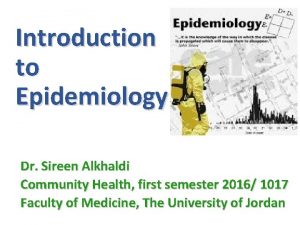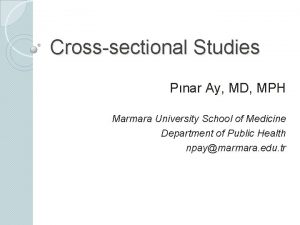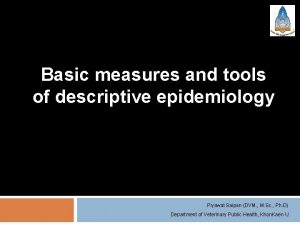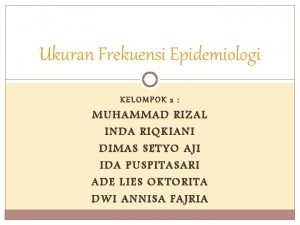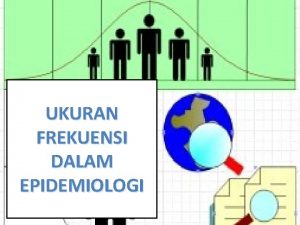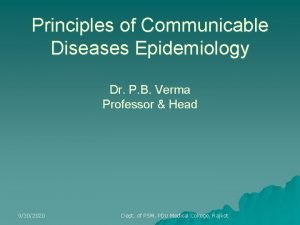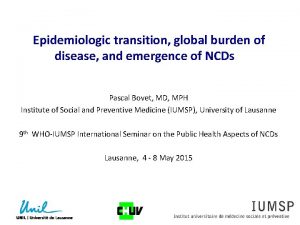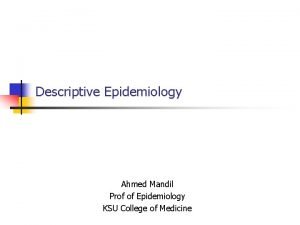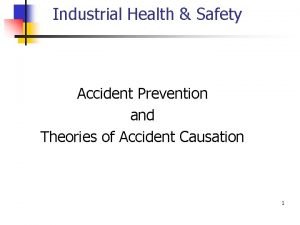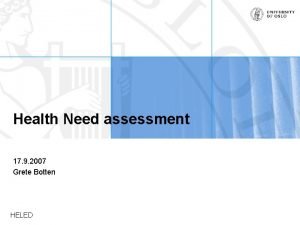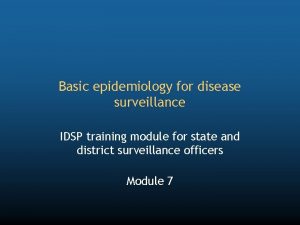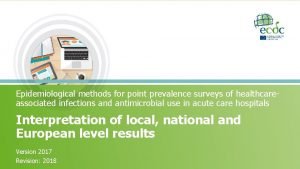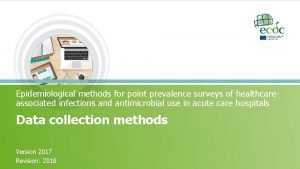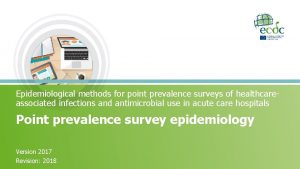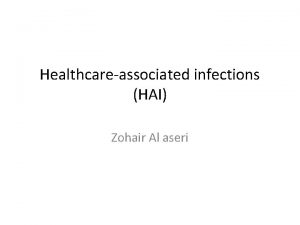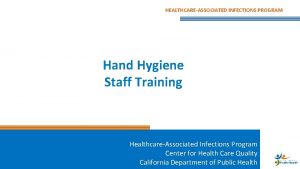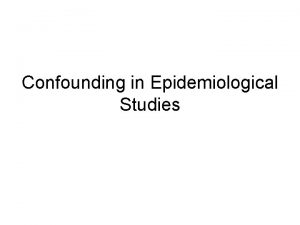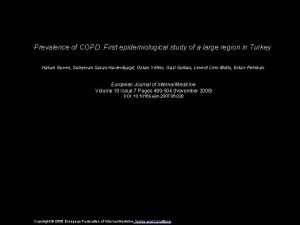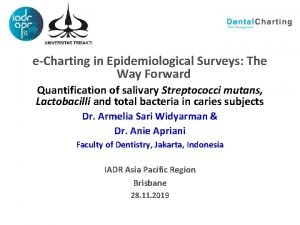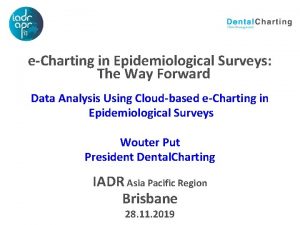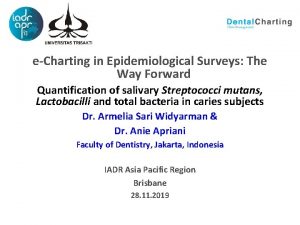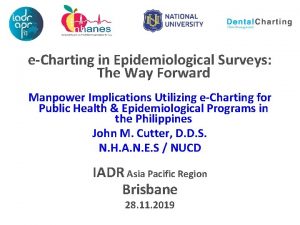Epidemiological methods for point prevalence surveys of healthcareassociated



















- Slides: 19

Epidemiological methods for point prevalence surveys of healthcareassociated infections and antimicrobial use in acute care hospitals ECDC point prevalence survey (PPS) 2016 -2017 Version 2017 Revision: 2018

Objectives Specific objectives of this session: 1. Learn about the background to the ECDC PPS 2. Learn about the main results of the ECDC PPS 2011 -2012 3. Learn about the aims of and participation in the ECDC PPS 2016 -2017 Related to the course objectives: A. Describe the aims and objectives of the ECDC PPS B. Understand the reporting output from the ECDC PPS 3

Outline This session consists of the following elements 1. Background • Healthcare-associated infections in Europe • The role of ECDC in HAI surveillance? • Why carry out a European prevalence survey? 2. Prevalence of HAI in Europe • Results from the ECDC PPS 2011 -2012 • Aims and objectives of ECDC PPS 2016 -2017 • Inclusion/exclusion criteria • Explanation for inclusion of the participants’ hospital • Interpretation of the ECDC PPS results 4

Background 5

What is the role of European Centre for Disease Prevention and Control (ECDC)? Identify, assess & communicate current & emerging health threats to human health from communicable diseases (ECDC Founding Regulation (851/2004), Article 1) – EU-level disease surveillance – Scientific opinions and studies – Early Warning System and Response – Technical assistance and training – Epidemic intelligence – Communication to scientific community – Communication to the public

Surveillance of healthcare-associated infections (HAI) by ECDC in Europe Ongoing HAI surveillance activities: Surgical site infections HAI in intensive care units Source: ECDC, HAI-Net surveillance data 2013 -2014

Surveillance of HAI in Europe (continued) • Further ongoing HAI surveillance activities: – HAI in long-term care facilities • Repeated Point Prevalence Surveys (PPS) − Clostridium difficile infection surveillance • Launched in the beginning of 2016 • Structure and process indicators for infection control are integrated to each surveillance activity.

Surveillance of healthcare-associated infections and benchmarking contributes to control Trends in cumulative incidence of surgical site infections (SSI) in hip prosthesis surgery (HPRO) by country, 2008 -2011 9

Why carry out an ECDC prevalence survey? An external ECDC evaluation in 2008 recommended that: • “The European HAI surveillance needs to cover other types of nosocomial infections besides surgical site infections and ICU-acquired infections in order to estimate and monitor the complete HAI disease burden. ” • “Since the implementation of an expanded continuous incidence surveillance is very resource demanding, hospital-wide prevalence surveys are efficient approaches to address it. ” Prevalence survey can be used to describe key structures and processes for the prevention of HAIs and antimicrobial resistance at the hospital and ward level in EU hospitals. 10

Prevalence of HAI in Europe 11

Prevalence surveys in Europe, 1990 -2008: need for harmonized methods Mean HAI prevalence 7% Mean HAI incidence 5%

Participation in the ECDC Point Prevalence Survey (PPS) 2011 -2012 • 30 countries • Over 1 000 hospitals • More than 200 000 patients

ECDC Point Prevalence Survey 2011 -2012

Healthcare-associated infections and antimicrobial use by country in the ECDC PPS 2011 -2012

Objectives of ECDC PPS 2016 -2017 1. To estimate the total burden (prevalence) of HAI & antimicrobial use 2. To describe patients, invasive procedures, infections (sites, microorganisms including markers of antimicrobial resistance) and antimicrobials prescribed (compounds, indications) • By type of patients, specialties or healthcare facilities • By EU-country, adjusted or stratified 3. To describe key structures and processes for the prevention of HAI and antimicrobial resistance at the hospital and ward level in EU hospitals 4. To disseminate results to those who need to know at local, regional, national and EU level 5. • Raise awareness • Train and reinforce surveillance structures and skills • Identify common EU problems and set up priorities accordingly • Evaluate the effect of strategies and guide policies (repeated PPS) To provide a standardised tool for hospitals to identify targets for quality improvement 16

Included/Excluded? INCLUDED EXCLUDED Hospitals • All acute care hospitals / facilities • Long-term care facilities • All sizes Wards • All hospital wards, both acute and long-term care (including psychiatric wards & neonatal units) • Accident and Emergency departments • Wards attached to Accident and Emergency (A&E) departments / Emergency Rooms (ER) where patients are monitored >24 hours Patients • All admitted to ward before 8 AM and not discharged at the time of the survey Patients • Day cases including: same day treatment or surgery, outpatient, or emergency room (A&E) episode, renal dialysis day attenders

Why was your hospital selected? • The ECDC has designed a systematic sampling design. • In practice, countries with less than 25 hospitals include all hospitals. • Countries with more than 25 hospitals randomly select the appropriate number of hospitals (and also at this time randomly selected a reserve list). • You have been chosen because you were on that list and have accepted the invitation to participate. THIS SLIDE MAY NEED TO ALTERED BY YOUR COUNTRY DEPENDING ON HOW YOU SELECTED YOUR HOSPITAL 18

What results will the ECDC PPS 2016 -2017 provide? European Level • European prevalence can be calculated in all acute care hospitals in the EU. National Level • National prevalence can be calculated, but may be less representative in countries which do not use a systematic sampling framework. Hospital Level • Hospital prevalence can be calculated for included hospitals individually and by administrative hospital group. Ward Level • Prevalence can be calculated for each ward including information on HAI types and antimicrobial use. 19

Acknowledgements The creation of this training material was commissioned in 2010 by ECDC to Health Protection Agency (UK) with the direct involvement of Dr. S. Hopkins, Prof. J. Reilly, S. Cairns, Dr. E. Sheridan, Dr. G. Hughes, Prof. B. Cookson, Dr. A. Charlett, G. Kafatos, B. Muller Pebody, F. Cowan, and Y. Sueiro. The revision and update of this training material was commissioned in 2017 by ECDC to Transmissible (NL) with the direct involvement of Dr. Arnold Bosman and Dr. Ágnes Hajdu 20
 Period prevalence vs point prevalence
Period prevalence vs point prevalence Period prevalence vs point prevalence
Period prevalence vs point prevalence Period prevalence vs point prevalence
Period prevalence vs point prevalence Period prevalence vs point prevalence
Period prevalence vs point prevalence Contoh soal prevalence rate
Contoh soal prevalence rate Point prevalence rate adalah
Point prevalence rate adalah Prevalence calculation
Prevalence calculation Epidemiological triad
Epidemiological triad Wheel theory of disease causation
Wheel theory of disease causation Stages of epidemiological transition
Stages of epidemiological transition Abdel omran epidemiological transition
Abdel omran epidemiological transition Epidemiologic transition
Epidemiologic transition Epidemiological triad
Epidemiological triad Combination theory of accident causation
Combination theory of accident causation What is epidemiological approach
What is epidemiological approach Epidemiological triad of malaria
Epidemiological triad of malaria What is epidemiological approach
What is epidemiological approach Epidemiological diagnosis
Epidemiological diagnosis Demographic momentum ap human geography
Demographic momentum ap human geography Demographic transition model
Demographic transition model
